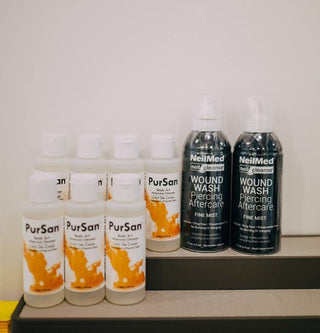Signs of Infection
Knowing the difference between what’s normal and what could be an infected tattoo can be crucial in preventing a minor infection from becoming a catastrophe. Some degree of redness, pain, and a small amount of swelling is normal after any tattoo. These symptoms should clear up within a few days. If it’s looking like it’s getting worse after a week, rather than healing, it’s time to take a closer look for any signs of an infection’s presence in the body.
Signs of infection include:
Increased pain or swelling on or around the tattoo. The “raw” reddish appearance of the tattoo increasing and spreading instead of fading and healing after a few days. Itchy or painful lumps or bumps under the skin. Pus, discharge, or open sores are appearing. A putrid smell. Fever, chills, or shivering. In the case of fever or chills developing, seek immediate medical advice. A fever may indicate that the infection has spread into your bloodstream, and immediate intervention will be needed to avoid sepsis from spreading.Types of Infection
Most infections are minor and bacterial in nature. If caught early enough, a course of antibiotics can usually be enough to treat it effectively.Five common infections stem from:
1, Staphylococcal Bacteria It is the most common strain of bacteria to cause infection. The strain responds well to antibiotics and, if caught and treated early, further complications are rare. 2. Nontuberculous Mycobacteria (NTM) Another minor infection that presents as itchy transparent or red patches on the tattoo, the NTM infection can be stopped easily. The bacteria are usually caught through contaminated water that is used to dilute the tattoo ink. 3. Methicillin-Resistant Staphylococcus Aureus (MRSA) MRSA is a more serious infection that has evolved into a resistant strain against antibiotics. It can lead to other complications, such as TSS, organ failure, sepsis, and coma, in extreme circumstances. MRSA is rare in an otherwise healthy person that treats a standard Staph infection early and effectively. 4. Viral Infections Other infections can be viral in nature and introduced through the use of unsterilized equipment, for example. These viral contaminants include Herpes simplex, viral Hepatitis B and C, Syphilis, and HIV. 5. Allergic reactions Some people can have an allergic reaction to a specific colour of ink, for example. It comes down to the metals used in the manufacture of the substance. The mercury sulphide in red is the most common colour to cause an allergy, with symptoms of blistering, crusting, and swelling becoming apparent. An allergic reaction can range in severity from mild to severe. Mild skin reactions include granulomas, lichenoid, or itchy patches or nodules. A severe allergic reaction, or anaphylactic shock, is life-threatening and needs immediate medical advice. Symptoms of anaphylactic shock include shallow breathing, a racing pulse, dizziness, chest tightness, nausea, and swelling. Immediate medical intervention is necessary.Reasons for Infection
Any introduction of foreign materials to the body exposes it to the risk of infection. Strict hygiene standards, proper skin preparation work, and the correct tattoo aftercare can help avoid an infected tattoo. Here are three common causes of infection: 1. Poor hygiene standards The use of unsterile equipment or contaminated water to dilute the ink can introduce bacteria into the area. A reputable tattoo artist will follow Universal Precautions, the standard for anyone who could be in contact with blood or bodily fluids. They will always use sterile, single-use needles and make sure your skin is correctly prepared before the procedure. 2. Incorrect skin preparation Before beginning, your skin needs to be cleaned using antibacterial methods. Removing as much bacteria as possible from your skin can reduce the risk of introducing bacteria under the skin. 3. Improper tattoo aftercare The tattoo needs to be kept clean and dry for several weeks until it heals. Poor hygiene or swimming too soon may increase the risk of infection on recently tattooed skin.How to Treat an Infection
If you suspect your tattoo has become infected, speak to your doctor or dermatologist straight away. The longer you leave an infection, the worse the consequences. It can be tempting to try to clean it up yourself and throw on some antibacterial cream, but the longer you leave it to wait for medical advice, the worse the outcome. Following a consultation, you will probably be prescribed a combination of topical and oral antibiotics to stop the infection in its tracks. A mild infection will usually be treated in a couple of weeks, while a more severe or systemic case might require several months of antibiotic treatment. It’s a great reason to get the issue sorted out quickly.
Ways to Avoid Infection
We don’t recommend trying to treat an infected tattoo without medical intervention. We do suggest trying to avoid an infection in the first place, though. Thankfully, it’s relatively easy to avoid an infected tattoo. Here are three tips to help you avoid the antibiotics: Choose a reputable tattoo studio. Shop around, visit a few places and test the vibe. A good studio will feel clean and sterile and use single-use needles. They will also be happy to talk to you about their hygiene procedures. Follow your tattoo aftercare advice. It means keeping your tattoo clean and dry and avoiding baths, hot tubs, pools, and the ocean for a minimum of four weeks after the procedure. Pay special attention if your tattoo is in an area prone to sweating. The armpit, lower back, or groin are specific areas that harbour bacteria from sweat. They need to be kept clean and sweat-free to stop the introduction of bacteria to the tattoo. Tattoos are an exciting and unique path to self-expression, and complications of newly tattooed skin are relatively rare. Knowing the symptoms of an infected tattoo and treating it early can stop a minor infection from becoming a major problem. Our advice is to stick with reputable artists, follow the aftercare advice, and seek prompt medical advice if anything seems wrong.Ready to Explore Your Own Custom Tattoo?
At Chronic Ink Tattoo, our talented artists are ready to help you explore Custom tattoos to make sure you find something you’ll want to show off for decades to come. If you’re in the Toronto, Markham, Mississauga, Kitsilano Vancouver area drop by our shop and check us out for yourself.
Tell us Your IdeaTattoo Studio Locations
Downtown Toronto
378 Yonge Street, 2nd Floor, Toronto, Ontario M5B 1S6 Directions
Midtown Toronto
252 Eglinton Ave East, 2nd Floor, Toronto, Ontario M4P 1K2 Directions
Markham
7381 Kennedy Road, Unit #105, Markham, Ontario L3R 5B5 Directions
Mississauga
100 City Centre Dr., Unit #2-311, Mississauga, Ontario L5N 2C9 Directions
Vancouver
1804 W 4th Ave, Vancouver, British Columbia V6J 1M3 Directions
Looking for your next Tattoo Idea?
Browse our selection of one of a kinda tattoo designs created by our Chronic Ink artists. Each piece is individual and will only ever be tattooed once.


